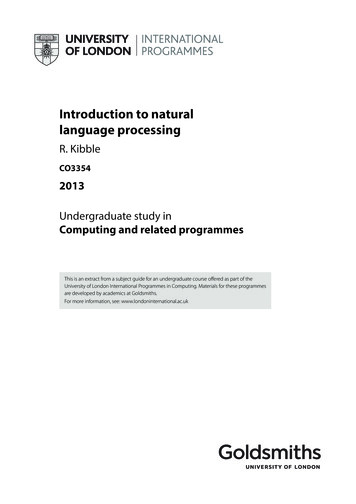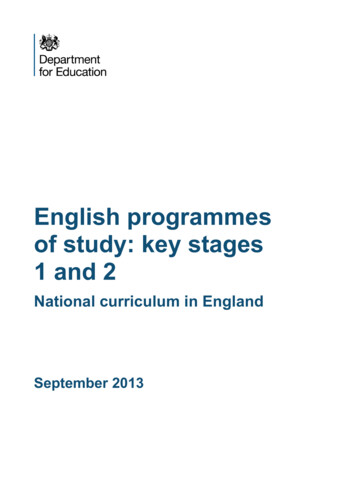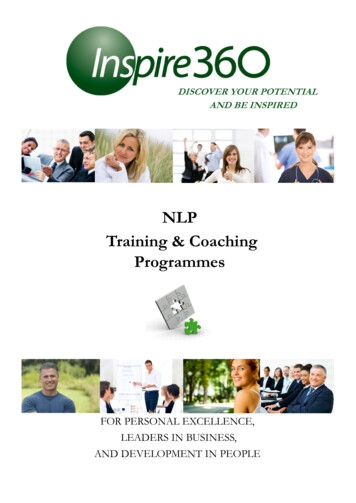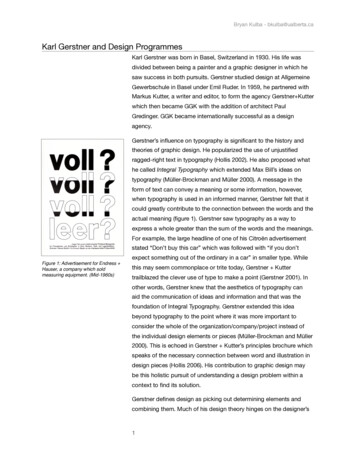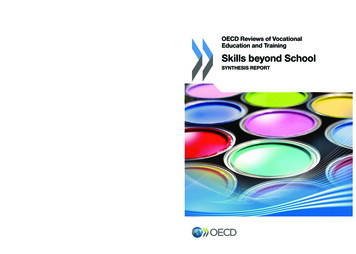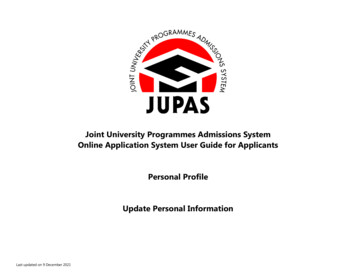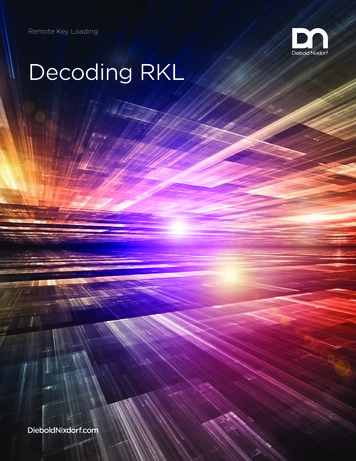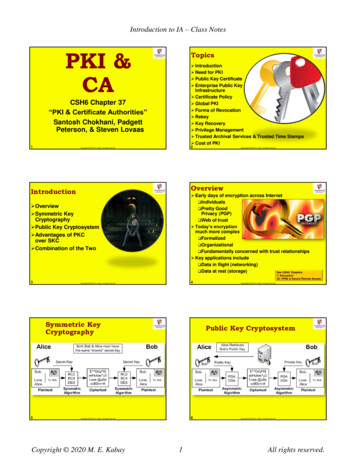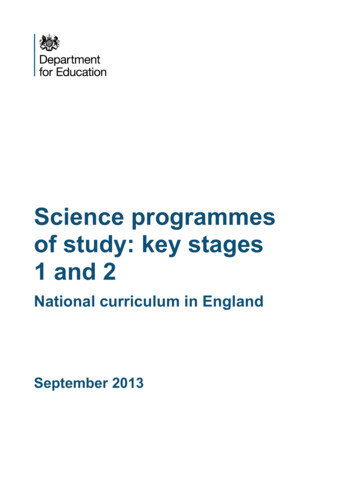
Transcription
Science programmesof study: key stages1 and 2National curriculum in EnglandSeptember 2013
ContentsKey stage 15Key stage 1 programme of study – years 1 and 26Year 1 programme of study7Year 2 programme of study10Lower key stage 2 – years 3 and 413Lower key stage 2 programme of study14Year 3 programme of study16Year 4 programme of study20Upper key stage 2 – years 5 and 624Upper key stage 2 programme of study25Year 5 programme of study27Year 6 programme of study312
Science – key stages 1 and 2Purpose of studyA high-quality science education provides the foundations for understanding the worldthrough the specific disciplines of biology, chemistry and physics. Science has changedour lives and is vital to the world’s future prosperity, and all pupils should be taughtessential aspects of the knowledge, methods, processes and uses of science. Throughbuilding up a body of key foundational knowledge and concepts, pupils should beencouraged to recognise the power of rational explanation and develop a sense ofexcitement and curiosity about natural phenomena. They should be encouraged tounderstand how science can be used to explain what is occurring, predict how things willbehave, and analyse causes.AimsThe national curriculum for science aims to ensure that all pupils: develop scientific knowledge and conceptual understanding through the specificdisciplines of biology, chemistry and physics develop understanding of the nature, processes and methods of science throughdifferent types of science enquiries that help them to answer scientific questions aboutthe world around them are equipped with the scientific knowledge required to understand the uses andimplications of science, today and for the future.Scientific knowledge and conceptual understandingThe programmes of study describe a sequence of knowledge and concepts. While it isimportant that pupils make progress, it is also vitally important that they develop secureunderstanding of each key block of knowledge and concepts in order to progress to thenext stage. Insecure, superficial understanding will not allow genuine progression: pupilsmay struggle at key points of transition (such as between primary and secondary school),build up serious misconceptions, and/or have significant difficulties in understandinghigher-order content.Pupils should be able to describe associated processes and key characteristics incommon language, but they should also be familiar with, and use, technical terminologyaccurately and precisely. They should build up an extended specialist vocabulary. Theyshould also apply their mathematical knowledge to their understanding of science,including collecting, presenting and analysing data. The social and economic implicationsof science are important but, generally, they are taught most appropriately within the widerschool curriculum: teachers will wish to use different contexts to maximise their pupils’engagement with and motivation to study science.3
Science – key stages 1 and 2The nature, processes and methods of science‘Working scientifically’ specifies the understanding of the nature, processes and methodsof science for each year group. It should not be taught as a separate strand. The notesand guidance give examples of how ‘working scientifically’ might be embedded within thecontent of biology, chemistry and physics, focusing on the key features of scientificenquiry, so that pupils learn to use a variety of approaches to answer relevant scientificquestions. These types of scientific enquiry should include: observing over time; patternseeking; identifying, classifying and grouping; comparative and fair testing (controlledinvestigations); and researching using secondary sources. Pupils should seek answers toquestions through collecting, analysing and presenting data. ‘Working scientifically’ will bedeveloped further at key stages 3 and 4, once pupils have built up sufficient understandingof science to engage meaningfully in more sophisticated discussion of experimental designand control.Spoken languageThe national curriculum for science reflects the importance of spoken language in pupils’development across the whole curriculum – cognitively, socially and linguistically. Thequality and variety of language that pupils hear and speak are key factors in developingtheir scientific vocabulary and articulating scientific concepts clearly and precisely. Theymust be assisted in making their thinking clear, both to themselves and others, andteachers should ensure that pupils build secure foundations by using discussion to probeand remedy their misconceptions.School curriculumThe programmes of study for science are set out year-by-year for key stages 1 and 2.Schools are, however, only required to teach the relevant programme of study by the endof the key stage. Within each key stage, schools therefore have the flexibility to introducecontent earlier or later than set out in the programme of study. In addition, schools canintroduce key stage content during an earlier key stage if appropriate. All schools are alsorequired to set out their school curriculum for science on a year-by-year basis and makethis information available online.Attainment targetsBy the end of each key stage, pupils are expected to know, apply and understand thematters, skills and processes specified in the relevant programme of study.Schools are not required by law to teach the content indicated as being ‘non-statutory’.4
Science – key stages 1 and 2Key stage 1The principal focus of science teaching in key stage 1 is to enable pupils to experienceand observe phenomena, looking more closely at the natural and humanly-constructedworld around them. They should be encouraged to be curious and ask questions aboutwhat they notice. They should be helped to develop their understanding of scientific ideasby using different types of scientific enquiry to answer their own questions, includingobserving changes over a period of time, noticing patterns, grouping and classifyingthings, carrying out simple comparative tests, and finding things out using secondarysources of information. They should begin to use simple scientific language to talk aboutwhat they have found out and communicate their ideas to a range of audiences in a varietyof ways. Most of the learning about science should be done through the use of first-handpractical experiences, but there should also be some use of appropriate secondarysources, such as books, photographs and videos.‘Working scientifically’ is described separately in the programme of study, but must alwaysbe taught through and clearly related to the teaching of substantive science content in theprogramme of study. Throughout the notes and guidance, examples show how scientificmethods and skills might be linked to specific elements of the content.Pupils should read and spell scientific vocabulary at a level consistent with their increasingword reading and spelling knowledge at key stage 1.5
Science – key stages 1 and 2Key stage 1 programme of study – years 1 and 2Working scientificallyStatutory requirementsDuring years 1 and 2, pupils should be taught to use the following practical scientificmethods, processes and skills through the teaching of the programme of study content: asking simple questions and recognising that they can be answered in different ways observing closely, using simple equipment performing simple tests identifying and classifying using their observations and ideas to suggest answers to questions gathering and recording data to help in answering questions.Notes and guidance (non-statutory)Pupils in years 1 and 2 should explore the world around them and raise their ownquestions. They should experience different types of scientific enquiries, includingpractical activities, and begin to recognise ways in which they might answer scientificquestions. They should use simple features to compare objects, materials and livingthings and, with help, decide how to sort and group them, observe changes over time,and, with guidance, they should begin to notice patterns and relationships. They shouldask people questions and use simple secondary sources to find answers. They shoulduse simple measurements and equipment (for example, hand lenses, egg timers) togather data, carry out simple tests, record simple data, and talk about what they havefound out and how they found it out. With help, they should record and communicatetheir findings in a range of ways and begin to use simple scientific language.These opportunities for working scientifically should be provided across years 1 and 2 sothat the expectations in the programme of study can be met by the end of year 2. Pupilsare not expected to cover each aspect for every area of study.6
Science – key stages 1 and 2Year 1 programme of studyPlantsStatutory requirementsPupils should be taught to: identify and name a variety of common wild and garden plants, including deciduousand evergreen trees identify and describe the basic structure of a variety of common flowering plants,including trees.Notes and guidance (non-statutory)Pupils should use the local environment throughout the year to explore and answerquestions about plants growing in their habitat. Where possible, they should observe thegrowth of flowers and vegetables that they have planted.They should become familiar with common names of flowers, examples of deciduousand evergreen trees, and plant structures (including leaves, flowers (blossom), petals,fruit, roots, bulb, seed, trunk, branches, stem).Pupils might work scientifically by: observing closely, perhaps using magnifying glasses,and comparing and contrasting familiar plants; describing how they were able to identifyand group them, and drawing diagrams showing the parts of different plants includingtrees. Pupils might keep records of how plants have changed over time, for example theleaves falling off trees and buds opening; and compare and contrast what they havefound out about different plants.Animals, including humansStatutory requirementsPupils should be taught to: identify and name a variety of common animals including fish, amphibians, reptiles,birds and mammals identify and name a variety of common animals that are carnivores, herbivores andomnivores7
Science – key stages 1 and 2Statutory requirements describe and compare the structure of a variety of common animals (fish,amphibians, reptiles, birds and mammals, including pets) identify, name, draw and label the basic parts of the human body and say which partof the body is associated with each sense.Notes and guidance (non-statutory)Pupils should use the local environment throughout the year to explore and answerquestions about animals in their habitat. They should understand how to take care ofanimals taken from their local environment and the need to return them safely afterstudy. Pupils should become familiar with the common names of some fish, amphibians,reptiles, birds and mammals, including those that are kept as pets.Pupils should have plenty of opportunities to learn the names of the main body parts(including head, neck, arms, elbows, legs, knees, face, ears, eyes, hair, mouth, teeth)through games, actions, songs and rhymes.Pupils might work scientifically by: using their observations to compare and contrastanimals at first hand or through videos and photographs, describing how they identifyand group them; grouping animals according to what they eat; and using their senses tocompare different textures, sounds and smells.Everyday materialsStatutory requirementsPupils should be taught to: distinguish between an object and the material from which it is made identify and name a variety of everyday materials, including wood, plastic, glass,metal, water, and rock describe the simple physical properties of a variety of everyday materials compare and group together a variety of everyday materials on the basis of theirsimple physical properties.8
Science – key stages 1 and 2Notes and guidance (non-statutory)Pupils should explore, name, discuss and raise and answer questions about everydaymaterials so that they become familiar with the names of materials and properties suchas: hard/soft; stretchy/stiff; shiny/dull; rough/smooth; bendy/not bendy; waterproof/notwaterproof; absorbent/not absorbent; opaque/transparent. Pupils should explore andexperiment with a wide variety of materials, not only those listed in the programme ofstudy, but including for example: brick, paper, fabrics, elastic, foil.Pupils might work scientifically by: performing simple tests to explore questions,for example: ‘What is the best material for an umbrella? .for lining a dog basket?.for curtains? .for a bookshelf? .for a gymnast’s leotard?’Seasonal changesStatutory requirementsPupils should be taught to: observe changes across the four seasons observe and describe weather associated with the seasons and how day lengthvaries.Notes and guidance (non-statutory)Pupils should observe and talk about changes in the weather and the seasons.Note: Pupils should be warned that it is not safe to look directly at the Sun, even whenwearing dark glasses.Pupils might work scientifically by: making tables and charts about the weather; andmaking displays of what happens in the world around them, including day length, as theseasons change.9
Science – key stages 1 and 2Year 2 programme of studyLiving things and their habitatsStatutory requirementsPupils should be taught to: explore and compare the differences between things that are living, dead, and thingsthat have never been alive identify that most living things live in habitats to which they are suited and describehow different habitats provide for the basic needs of different kinds of animals andplants, and how they depend on each other identify and name a variety of plants and animals in their habitats, including microhabitats describe how animals obtain their food from plants and other animals, using the ideaof a simple food chain, and identify and name different sources of food.Notes and guidance (non-statutory)Pupils should be introduced to the idea that all living things have certain characteristicsthat are essential for keeping them alive and healthy. They should raise and answerquestions that help them to become familiar with the life processes that are common toall living things. Pupils should be introduced to the terms ‘habitat’ (a natural environmentor home of a variety of plants and animals) and ‘micro-habitat’ (a very small habitat, forexample for woodlice under stones, logs or leaf litter). They should raise and answerquestions about the local environment that help them to identify and study a variety ofplants and animals within their habitat and observe how living things depend on eachother, for example, plants serving as a source of food and shelter for animals. Pupilsshould compare animals in familiar habitats with animals found in less familiar habitats,for example, on the seashore, in woodland, in the ocean, in the rainforest.Pupils might work scientifically by: sorting and classifying things according to whetherthey are living, dead or were never alive, and recording their findings using charts. Theyshould describe how they decided where to place things, exploring questions forexample: ‘Is a flame alive? Is a deciduous tree dead in winter?’ and talk about ways ofanswering their questions. They could construct a simple food chain that includeshumans (e.g. grass, cow, human). They could describe the conditions in differenthabitats and micro-habitats (under log, on stony path, under bushes) and find out howthe conditions affect the number and type(s) of plants and animals that live there.10
Science – key stages 1 and 2PlantsStatutory requirementsPupils should be taught to: observe and describe how seeds and bulbs grow into mature plants find out and describe how plants need water, light and a suitable temperature to growand stay healthy.Notes and guidance (non-statutory)Pupils should use the local environment throughout the year to observe how differentplants grow. Pupils should be introduced to the requirements of plants for germination,growth and survival, as well as to the processes of reproduction and growth in plants.Note: Seeds and bulbs need water to grow but most do not need light; seeds and bulbshave a store of food inside them.Pupils might work scientifically by: observing and recording, with some accuracy, thegrowth of a variety of plants as they change over time from a seed or bulb, or observingsimilar plants at different stages of growth; setting up a comparative test to show thatplants need light and water to stay healthy.Animals, including humansStatutory requirementsPupils should be taught to: notice that animals, including humans, have offspring which grow into adults find out about and describe the basic needs of animals, including humans, forsurvival (water, food and air) describe the importance for humans of exercise, eating the right amounts of differenttypes of food, and hygiene.Notes and guidance (non-statutory)Pupils should be introduced to the basic needs of animals for survival, as well as theimportance of exercise and nutrition for humans. They should also be introduced to theprocesses of reproduction and growth in animals. The focus at this stage should be onquestions that help pupils to recognise growth; they should not be expected tounderstand how reproduction occurs.11
Science – key stages 1 and 2Notes and guidance (non-statutory)The following examples might be used: egg, chick, chicken; egg, caterpillar, pupa,butterfly; spawn, tadpole, frog; lamb, sheep. Growing into adults can include reference tobaby, toddler, child, teenager, adult.Pupils might work scientifically by: observing, through video or first-hand observationand measurement, how different animals, including humans, grow; asking questionsabout what things animals need for survival and what humans need to stay healthy; andsuggesting ways to find answers to their questions.Uses of everyday materialsStatutory requirementsPupils should be taught to: identify and compare the suitability of a variety of everyday materials, includingwood, metal, plastic, glass, brick, rock, paper and cardboard for particular uses find out how the shapes of solid objects made from some materials can be changedby squashing, bending, twisting and stretching.Notes and guidance (non-statutory)Pupils should identify and discuss the uses of different everyday materials so that theybecome familiar with how some materials are used for more than one thing (metal canbe used for coins, cans, cars and table legs; wood can be used for matches, floors, andtelegraph poles) or different materials are used for the same thing (spoons can be madefrom plastic, wood, metal, but not normally from glass). They should think about theproperties of materials that make them suitable or unsuitable for particular purposes andthey should be encouraged to think about unusual and creative uses for everydaymaterials. Pupils might find out about people who have developed useful new materials,for example John Dunlop, Charles Macintosh or John McAdam.Pupils might work scientifically by: comparing the uses of everyday materials in andaround the school with materials found in other places (at home, the journey to school,on visits, and in stories, rhymes and songs); observing closely, identifying andclassifying the uses of different materials, and recording their observations.12
Science – key stages 1 and 2Lower key stage 2 – years 3 and 4The principal focus of science teaching in lower key stage 2 is to enable pupils to broadentheir scientific view of the world around them. They should do this through exploring,talking about, testing and developing ideas about everyday phenomena and therelationships between living things and familiar environments, and by beginning to developtheir ideas about functions, relationships and interactions. They should ask their ownquestions about what they observe and make some decisions about which types ofscientific enquiry are likely to be the best ways of answering them, including observingchanges over time, noticing patterns, grouping and classifying things, carrying out simplecomparative and fair tests and finding things out using secondary sources of information.They should draw simple conclusions and use some scientific language, first, to talk aboutand, later, to write about what they have found out.‘Working scientifically’ is described separately at the beginning of the programme of study,but must always be taught through and clearly related to substantive science content inthe programme of study. Throughout the notes and guidance, examples show howscientific methods and skills might be linked to specific elements of the content.Pupils should read and spell scientific vocabulary correctly and with confidence, using theirgrowing word reading and spelling knowledge.13
Science – key stages 1 and 2Lower key stage 2 programme of studyWorking scientificallyStatutory requirementsDuring years 3 and 4, pupils should be taught to use the following practical scientificmethods, processes and skills through the teaching of the programme of study content: asking relevant questions and using different types of scientific enquiries to answerthem setting up simple practical enquiries, comparative and fair tests making systematic and careful observations and, where appropriate, taking accuratemeasurements using standard units, using a range of equipment, includingthermometers and data loggers gathering, recording, classifying and presenting data in a variety of ways to help inanswering questions recording findings using simple scientific language, drawings, labelled diagrams,keys, bar charts, and tables reporting on findings from enquiries, including oral and written explanations, displaysor presentations of results and conclusions using results to draw simple conclusions, make predictions for new values, suggestimprovements and raise further questions identifying differences, similarities or changes related to simple scientific ideas andprocesses using straightforward scientific evidence to answer questions or to support theirfindings.Notes and guidance (non-statutory)Pupils in years 3 and 4 should be given a range of scientific experiences to enable themto raise their own questions about the world around them. They should start to maketheir own decisions about the most appropriate type of scientific enquiry they might useto answer questions; recognise when a simple fair test is necessary and help to decidehow to set it up; talk about criteria for grouping, sorting and classifying; and use simplekeys. They should begin to look for naturally occurring patterns and relationships anddecide what data to collect to identify them. They should help to make decisions aboutwhat observations to make, how long to make them for and the type of simpleequipment that might be used.14
Science – key stages 1 and 2Notes and guidance (non-statutory)They should learn how to use new equipment, such as data loggers, appropriately. Theyshould collect data from their own observations and measurements, using notes, simpletables and standard units, and help to make decisions about how to record and analysethis data. With help, pupils should look for changes, patterns, similarities and differencesin their data in order to draw simple conclusions and answer questions. With support,they should identify new questions arising from the data, making predictions for newvalues within or beyond the data they have collected and finding ways of improving whatthey have already done. They should also recognise when and how secondary sourcesmight help them to answer questions that cannot be answered through practicalinvestigations. Pupils should use relevant scientific language to discuss their ideas andcommunicate their findings in ways that are appropriate for different audiences.These opportunities for working scientifically should be provided across years 3 and 4 sothat the expectations in the programme of study can be met by the end of year 4. Pupilsare not expected to cover each aspect for every area of study.15
Science – key stages 1 and 2Year 3 programme of studyPlantsStatutory requirementsPupils should be taught to: identify and describe the functions of different parts of flowering plants: roots,stem/trunk, leaves and flowers explore the requirements of plants for life and growth (air, light, water, nutrients fromsoil, and room to grow) and how they vary from plant to plant investigate the way in which water is transported within plants explore the part that flowers play in the life cycle of flowering plants, includingpollination, seed formation and seed dispersal.Notes and guidance (non-statutory)Pupils should be introduced to the relationship between structure and function: the ideathat every part has a job to do. They should explore questions that focus on the role ofthe roots and stem in nutrition and support, leaves for nutrition and flowers forreproduction.Note: Pupils can be introduced to the idea that plants can make their own food, but atthis stage they do not need to understand how this happens.Pupils might work scientifically by: comparing the effect of different factors on plantgrowth, for example, the amount of light, the amount of fertiliser; discovering how seedsare formed by observing the different stages of plant life cycles over a period of time;looking for patterns in the structure of fruits that relate to how the seeds are dispersed.They might observe how water is transported in plants, for example, by putting cut, whitecarnations into coloured water and observing how water travels up the stem to theflowers.16
Science – key stages 1 and 2Animals, including humansStatutory requirementsPupils should be taught to: identify that animals, including humans, need the right types and amount of nutrition,and that they cannot make their own food; they get nutrition from what they eat identify that humans and some other animals have skeletons and muscles forsupport, protection and movement.Notes and guidance (non-statutory)Pupils should continue to learn about the importance of nutrition and should beintroduced to the main body parts associated with the skeleton and muscles, finding outhow different parts of the body have special functions.Pupils might work scientifically by: identifying and grouping animals with and withoutskeletons and observing and comparing their movement; exploring ideas about whatwould happen if humans did not have skeletons. They might compare and contrast thediets of different animals (including their pets) and decide ways of grouping themaccording to what they eat. They might research different food groups and how theykeep us healthy and design meals based on what they find out.RocksStatutory requirementsPupils should be taught to: compare and group together different kinds of rocks on the basis of their appearanceand simple physical properties describe in simple terms how fossils are formed when things that have lived aretrapped within rock recognise that soils are made from rocks and organic matter.Notes and guidance (non-statutory)Linked with work in geography, pupils should explore different kinds of rocks and soils,including those in the local environment.17
Science – key stages 1 and 2Notes and guidance (non-statutory)Pupils might work scientifically by: observing rocks, including those used in buildingsand gravestones, and exploring how and why they might have changed over time; usinga hand lens or microscope to help them to identify and classify rocks according towhether they have grains or crystals, and whether they have fossils in them. Pupilsmight research and discuss the different kinds of living things whose fossils are found insedimentary rock and explore how fossils are formed. Pupils could explore different soilsand identify similarities and differences between them and investigate what happenswhen rocks are rubbed together or what changes occur when they are in water. Theycan raise and answer questions about the way soils are formed.LightStatutory requirementsPupils should be taught to: recognise that they need light in order to see things and that dark is the absence oflight notice that light is reflected from surfaces recognise that light from the sun can be dangerous and that there are ways to protecttheir eyes recognise that shadows are formed when the light from a light source is blocked byan opaque object find patterns in the way that the size of shadows change.Notes and guidance (non-statutory)Pupils should explore what happens when light reflects off a mirror or other reflectivesurfaces, including playing mirror games to help them to answer questions about howlight behaves. They should think about why it is important to protect their eyes frombright lights. They should look for, and measure, shadows, and find out how they areformed and what might cause the shadows to change.Note: Pupils should be warned that it is not safe to look directly at the Sun, even whenwearing dark glasses.Pupils might work scientifically by: looking for patterns in what happens to shadowswhen the light source moves or the distance between the light source and the objectchanges.18
Science – key stages 1 and 2Forces and magnetsStatutory requirementsPupils should be taught to: compare how things move on different surfaces notice that some forces need contact between two objects, but magnetic forces canact at a distance observe how magnets attract or repel each other and attract some materials and notothers compare and group together a variety of everyday materials on the basis of whetherthey are attracted to a magnet, and identify some magnetic materials describe magnets as having two poles predict whether two magnets will attract or repel each other, depending on whichpoles are facing.Notes a
Science – key stages 1 and 2 5 . Key stage 1 . The principal focus of science teaching in key stage 1 is to enable pupils to experience and observe phenomena, looking more closely at the natural and humanly-constructed world around them. They should be encourage
